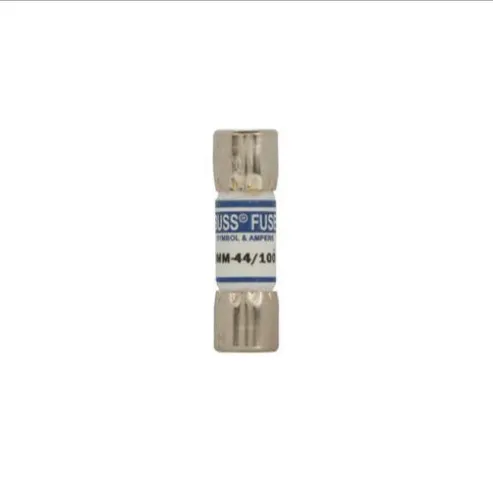Bussmann DMM-B-44/100 fast-acting ferrule fuse opens the electrical circuit in case of overload and short-circuits quickly. This fuse is effective in multi-meters.
Features:
- Bussmann DMM-B-44/100 fast-acting ferrule fuse has melamine tube construction for superior arc-resistant capabilities.
- It has nickel-plated end caps to establish a conductive connection with an electrical conductor.
- This fuse is available in holder mounting style with clip terminals to facilitate easy installation in cramped spaces.
- It has the capability to carry 100% of the rated current (440mA).
Frequently Asked Questions:
Q. How fast does a fuse burn?
A. Safety fuses are manufactured with specified burn times per 30 cm, such as 60 seconds, implying that a fuse 30 cm long will take 60 seconds to burn.
Q. What is the difference between interrupting rating and the ampere rating?
A. The interrupting rating is the maximum amount of energy that the device can safely withstand. The ampere rating of a fuse is the amount of current that the fuse will allow to pass before it begins to operate.
Q. What is the significance of the interrupting rating?
A. Bussmann DMM-B-44/100 fuse's interrupting rating is significant because it is a safety rating. If a device with a low interrupting rating is used in a circuit with a higher available fault current, the device may fail as it attempts to clear the fault, posing a safety hazard.
Q. What are the factors to consider while choosing this Bussmann DMM-B-44/100 fast-acting ferrule fuse?
A. Major factors include current & voltage ratings, type of protection, speed, environmental suitability, compliance with standards, compatibility, physical dimensions, ease of installation and expected lifespan.
Q. What is the current rating of this fast-acting ferrule fuse?
A. This fuse has a current rating of 0.04A. Customers looking for a higher current variant can opt Bussmanndmm-b-11a fuse having a current rating of 11A.
Q. What safety precautions should I take when installing or replacing this fuse?
A.
- Disconnect power before working on the circuit.
- Wear appropriate PPE, including gloves and safety goggles.
- Verify circuit de-energisation with a voltage tester.
- Use the correct fuse type and specifications.
- Inspect and repair damaged fuse holders.
- Handle the fuse by the insulated portion.
- Ensure proper seating in the fuse holder.
- Tighten connections securely but not excessively.
- Inspect for unintended shorts after installation.
- Reconnect power safely and test equipment.
- Dispose of old fuses following local regulations.
 Change Country
Change Country


 In Stock : 567 Units
In Stock : 567 Units